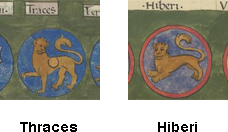
This page created 5 April 2014, and last modified: 13 January 2016 (Spanish Hiberian commentary added)

In the eastern half of the empire, the Hiberi is the 12th unit of auxilia palatina out of 18 listed (9.35 in Ingo Maier's numbering scheme) under the command of the first Magister Militum Praesentalis (i.e. "Master of the Soldiers in the Imperial Presence"). Its shield pattern (8#10) as shown in various manuscripts, under the matching label (8.k) Hiberi, is as below:

The shield pattern has a indigo-violet main field (more purple in B, faded to maroon in M, W), a red rim, and a brown lion walking to the left but (mostly) facing the viewer; the direction of the animal is, unusually, not reversed in B, which, being printed, usually does reverse the facings. A boss is depicted in O and W (only) positioned onalong the back of the animal; it is undifferentiated in colour in O, but is a paler colour, more yellow, in W. The pattern is closely related to that of the unit of exactly the same rank under the command of the other Master of the Soldiers in the Imperial Presence (a.k.a. the Magister Militum Praesentalis II): the Thraces (12.34), as the following patterns taken from the Paris manuscript should help to illustrate:

Both units would appear to be named after peoples inhabiting mountainous regions that were in ancient times also populated by lions: the Thracians the mountains of northern Greece/southern Bulgaria, and the Hiberians in the Caucasus. However, another people called the Hiberians also lived in what is now Spain, and the Hiberi may well be named after them instead; only one unit of auxilia palatina in the Notitia is otherwise named after a non-European ethnic group: the Felices Theodosiani [I]sauri (9.41). In any case, presumably the Hiberi and the Thraces were brigaded together before being split when the two parallel eastern Praesental armies were formed.
Inscriptional evidence for the Hiberi apparently comes from the cemetery at Colonia Iulia Concordia (modern Portogruaro in Veneto, Italy), which produced a surprisingly irregular inscription (CIL 5.8745) in the form of a gravestone of a centenarius which reads N EBORUM AUSILIUN PL, and which has been interpreted to mean the "numeri Iberorum auxilii palatini".
Only one other unit listed in the Notitia bears the name Hiberi: the Ala prima Hiberorum (56/7.25), under the Dux Thebaidos.
1. Ingo Maier; "Appendix 4: Numeration of the new edition of the compilation 'notitia dignitatum' (Cnd)"; last accessed 26 October 2015. See also for here for numbering examples. Return
2. Hoffmann, Dietrich; "Die Spätrömischen Soldatengrabschriften von Concordia"; Schweizerische Zeitschrift für klassische Altertumswissenschaft, Vol. 20.1 (1963), pp 22-57; available here (last accessed 8 December 2015). Return

Return to the Notitia alphabetical unit list page.
Return to my Notitia index page.